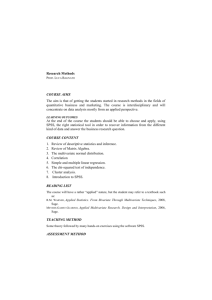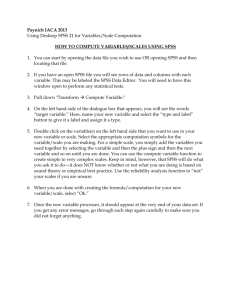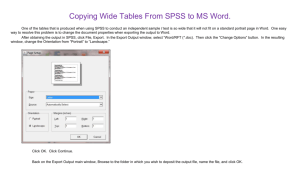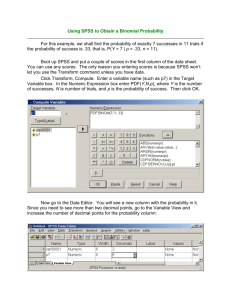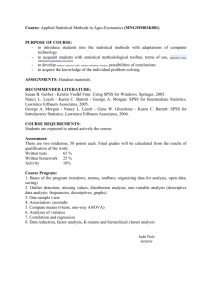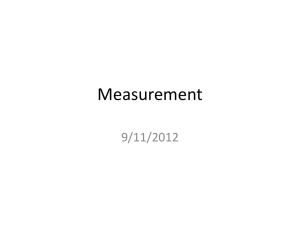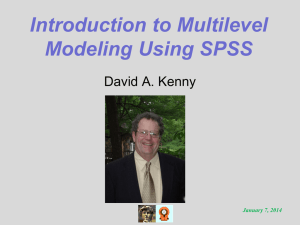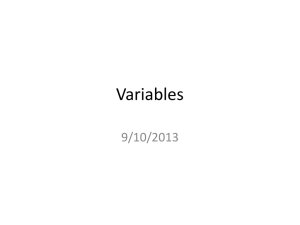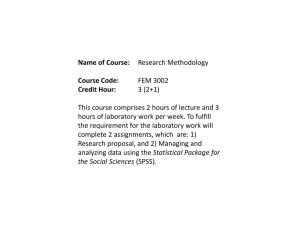Task 2: Testing a Hypothesis About Two Related Means
advertisement
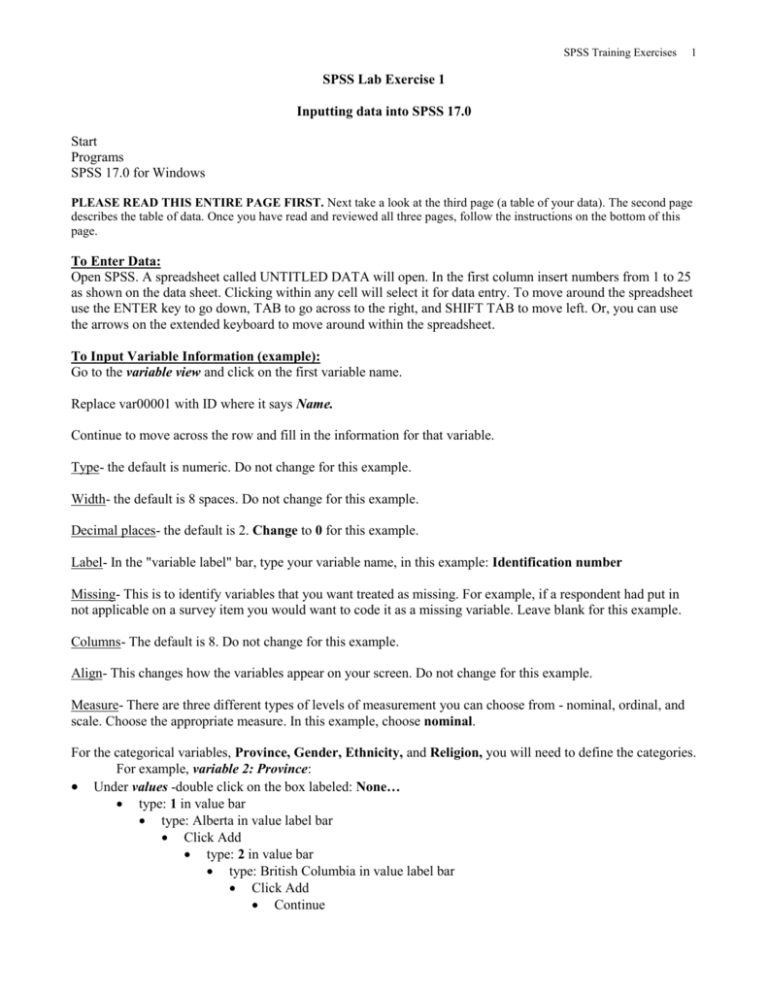
SPSS Training Exercises 1 SPSS Lab Exercise 1 Inputting data into SPSS 17.0 Start Programs SPSS 17.0 for Windows PLEASE READ THIS ENTIRE PAGE FIRST. Next take a look at the third page (a table of your data). The second page describes the table of data. Once you have read and reviewed all three pages, follow the instructions on the bottom of this page. To Enter Data: Open SPSS. A spreadsheet called UNTITLED DATA will open. In the first column insert numbers from 1 to 25 as shown on the data sheet. Clicking within any cell will select it for data entry. To move around the spreadsheet use the ENTER key to go down, TAB to go across to the right, and SHIFT TAB to move left. Or, you can use the arrows on the extended keyboard to move around within the spreadsheet. To Input Variable Information (example): Go to the variable view and click on the first variable name. Replace var00001 with ID where it says Name. Continue to move across the row and fill in the information for that variable. Type- the default is numeric. Do not change for this example. Width- the default is 8 spaces. Do not change for this example. Decimal places- the default is 2. Change to 0 for this example. Label- In the "variable label" bar, type your variable name, in this example: Identification number Missing- This is to identify variables that you want treated as missing. For example, if a respondent had put in not applicable on a survey item you would want to code it as a missing variable. Leave blank for this example. Columns- The default is 8. Do not change for this example. Align- This changes how the variables appear on your screen. Do not change for this example. Measure- There are three different types of levels of measurement you can choose from - nominal, ordinal, and scale. Choose the appropriate measure. In this example, choose nominal. For the categorical variables, Province, Gender, Ethnicity, and Religion, you will need to define the categories. For example, variable 2: Province: Under values -double click on the box labeled: None… type: 1 in value bar type: Alberta in value label bar Click Add type: 2 in value bar type: British Columbia in value label bar Click Add Continue SPSS Training Exercises OK Enter all the data and name all the variables in this manner, according to the description provided. Repeat this sequence for all the variables. Data Description Var1 Var2 Var3 Var4 Var5 Var6 Var7 Respondent's identification number (ID) Province the respondents lives in (PROVINCE) 1 Alberta 2 British Columbia Respondent's gender (GENDER) 1 male 2 female Respondent's ethnicity (ETHNICITY) 1 Caucasian 2 Black Respondent's age (AGE) Respondent's religious affiliation (RELIGION) 1 Protestant 2 Catholic 3 Jewish 4 None 5 Other Respondent' s mother‘s education - years of schooling (MAEDUC) Name your data set and save it the data (either to disk or to your student file) Note: Use this data to complete Exercise 1 Part B. 2 SPSS Training Exercises DATA SET 1 2 3 4 5 6 7 8 9 10 11 12 13 14 15 16 17 18 19 20 21 22 23 24 25 id province gender ethnicity age religion maeduc 1 2 3 4 5 6 7 8 9 10 11 12 13 14 15 16 17 18 19 20 21 22 23 24 25 1 1 1 1 1 1 1 1 1 1 1 1 2 2 2 2 2 2 2 2 2 2 2 2 2 1 2 2 2 1 1 2 1 2 1 2 2 2 1 1 1 2 1 1 2 1 2 1 2 2 1 1 2 1 1 1 2 2 2 2 1 2 2 1 2 1 1 1 1 2 2 2 1 2 1 32 37 72 86 30 32 29 29 53 68 19 43 38 45 24 53 20 27 54 25 20 38 20 34 67 1 2 2 3 1 2 1 1 1 1 2 2 4 2 4 2 2 2 2 1 2 2 2 2 1 16 13 20 12 5 10 18 4 6 9 2 14 12 17 1 3 7 11 8 15 1 7 5 10 19 3 SPSS Training Exercises 4 SPSS Lab Exercise 2 Running Frequencies and Descriptives in SPSS 17.0 There are 2 ways to retrieve the data file you saved in exercise 1: a) Enter SPSS. An untitled data sheet will appear. Click on File. Click on Open. Click on arrow under Drives: Click on a: (or relevant drive) Under file name, click on the file (.sav). OK. b) Click on My Computer icon. Click on or relevant drive. Click on data file (.sav). SPSS will be initiated and the data will appear. Open previous data file from Exercise 1. Task 1 To run frequencies for each variable, with the data editor open in the data view, go to: Analyze Descriptive Statistics Frequencies Click on the selected variable in the left box and transfer it to the Variable(s) box by clicking the arrow. Note: You can transfer more than one variable to the Variable(s) box and run frequencies for all variables at the same time. In the same window click on Statistics Select minimum, maximum, and range (they may already be selected as default) Continue In the same window click on Charts… Bar chart (You can also try a histogram with or without the normal curve, and a pie chart. However, SPSS will only allow you to select on 1 chart at a time!) Continue OK If you want you may name your output and save it. The computer will give the output an ‘.spv’ extension if you are using SPSS 17 or an ‘.spo’ extension if you are using another version of SPSS. This indicates that your frequencies are saved as an output file. Run frequencies for the following categorical (i.e., discrete) variables: Gender, Ethnicity, Religion, and Province. Answer the following questions: What percentage of the sample is female? ____________ What percentage of the sample is Black? ____________ What percentage of the sample is Catholic? ____________ What percentage of the sample is from Alberta? ____________ Task 2 To run Descriptives for each variable go to: Analyze Descriptive Statistics Descriptives Click on the selected variable in the left box and transfer it to the Variable(s) box by clicking the arrow. You can transfer more than one variable to the Variable(s) box and run descriptives for all variables at the same time. In the same window click on Options SPSS Training Exercises Select mean, standard deviation, minimum, maximum and range (some may already be selected as default) Continue OK If you want to you may name your output and save it. Run Descriptives for the continuous variables: Age, and Mother’s Education (maeduc). Fill in the following table. Variable Mean Standard Deviation Lowest Value Highest Value Range Age Mother’s Education (in years) Task 3 Now we want to review the process of cutting and pasting from your SPSS output into a Microsoft Word document. SPSS output should currently be open on the computer screen in front of you. Let's copy the Descriptives table you just had SPSS produce and paste it into a "hypothetical" Microsoft Word document. In order to copy and paste, you must: 1. Go back to the bottom left corner of your computer screen to the command Start. Click on Start. Click on Programs. Find Microsoft Word. Click on Microsoft Word. The Microsoft Word program should open up onto your computer screen. 2. Sometimes the Microsoft Word program will now ask you what you want to do. If the program asks, you want to create a new document. 3. Minimize your Microsoft Word program by clicking on the first of the three small boxes at the top right hand side of your screen. The box you want is gray, square, and contains only a small line through the box. 4. Now your SPSS output screen should be open in front of you. 5. Using your mouse, click once on the Descriptives table. The Descriptives table should now be surrounded by a box. 6. Using your mouse, move your pointer to the top of the SPSS output screen to the command Edit. Click on Edit. 7. Click on Copy Objects. 8. Now minimize your SPSS output screen by clicking on the first of the three small boxes at the top right hand side of your screen. The box you want is gray, square, and contains only a small line through the box. 9. Your Microsoft Word program should now be in front of you. 10. Click anywhere on the screen. There should now be a blinking cursor. Move the cursor down several lines (in case you want to add a title or a sentence about the SPSS descriptives table) by clicking on Enter several times. 11. Using your mouse, click on the Edit command at the top of your screen. Click on Paste. 12. Your SPSS Descriptives table should now appear in your Microsoft Word document. The Microsoft Word table should be identical to the SPSS table. 5 SPSS Training Exercises SPSS Lab Exercise 3 Frequencies Data manipulation: Recoding and Selecting Cases. Central Tendency Measures Histograms Task 1 Open your data file from Exercise 1. Imagine that you need to classify your respondents into five categories in terms of their ages. To do so you will need to create a new categorical variable. Recode the continuous variable Respondent's Age (age) into a new categorical variable (agegroup). The values for the new variable will be as follows: New Values (agegroup) Old values (age): 1 – late adolescent 2 – young adult 3 – middle adult 4 – late adult 18-20 21-40 41-60 61-90 Note: The width of these intervals are not equal. In a true study, we would want the interval widths to be consistent! In the menu bar go to Transform Recode Into different variable… Transfer “age” into Output variable box Type the name of a new variable - agegroup Click on Change Click on Old and New Values In Old values select Range and type the first range of the old values: 18-20 In New value type 1 Click on Add Repeat these steps for all old and new values Continue OK You should have a new variable (agrgroup) with the values 1 to 4. Now define the new variable and its value levels. (You do this under variable view) Now obtain the frequencies for agegroup: What age group category has the least number of participants/people? _________ What age group category has the most number of participants/people? _________ What % of the sample is late adult? _________ What % of the sample is young adult? _________ What % of the sample is middle adult? _________ 6 SPSS Training Exercises 7 Task 2 Run the frequencies for the following variables: maeduc and age. Now find the standard deviation, variance, minimum and maximum values for these variables. To do so, in the main menu bar go to: Analyze Descriptive Statistics Frequencies Click on the selected variables in the left box and transfer them to the Variable(s) box by clicking the right arrow. In the same window click on Statistics… Select appropriate statistics Continue Charts… Histogram Select Display normal curve Continue OK Variable Age Mean Median Mode Maximum Shape Maeeduc Task 3 Run frequencies for the variables age and years separately for males and females. To do this we need to select the cases according to respondent's gender. To run the frequencies for each gender we will first select males, run the frequencies for males, and then select females and run the frequencies for females. To select males: Go to Data Select cases If condition is satisfied If…gender =1 (Select Gender, click arrow, then select function =1) Continue (Please note: Unselected cases should be FILTERED as deleting the cases will delete them forever!) OK You have now selected only the males. Until you re-select everyone, reset the select feature, or select only females, all the statistics you do from this point forward will be based only on males! Next we need to run the frequencies: Analyze Descriptive Statistics Frequencies Statistics Move maeduc and age variables into Variable(s) box. SPSS Training Exercises Click on the boxes of standard deviation, variance, skewness, minimum, maximum, mean, mode, and median. Continue OK Your SPSS output will present your frequencies for males only. Note your sample size is smaller then it was during task 2. We have excluded the females from this analysis! Next, you will have to repeat these steps for analyzing the data for females. Before selecting females you will need to reset the data. In order to do so go to Data Select Cases Reset Now select only females using the following procedure and then re-run the frequency analysis. Go to Data Select cases If condition is satisfied If…gender =2 (Select Gender, click arrow, then select function =2) Continue (Please note: Unselected cases should be FILTERED as deleting the cases will delete them forever!) OK Use your output to answer the following questions: Variable Age/ M Mean Median Mode St. deviation Variance Shape Maeduc/ F Now produce the histogram with normal curve for these variables. Remember to select cases appropriately for each variable. In the main menu bar go to: 8 Graphs Histogram Transfer appropriate variable to Variable bar Select Display normal curve OK Another way to obtain the frequencies for males and females separately would have been to go to: Data o Split File Compare Groups Click on “Organize output by groups” o Move the gender variable from the left box into the middle box under “Groups Based On” Click OK. In order to unsplit the file, go back to Split File and select “Analyze all cases, do not create groups”. SPSS Training Exercises 9 ADDITIONAL SPSS TECHNIQUES Simple Correlation Task 1: Correlation between Two Variables Use the 1991 U.S. General Social Survey.dat data set (ITS website) to find the strength of the relationship between fathers’ education level (highest year of school completed, father: paeduc) and mother’s education level (highest year of school completed, mother: maeduc). In the main menu bar go to: Analyze Correlate Bivariate (meaning 2 variables)… Transfer the appropriate set of variables to the Variable box The default options selected are Pearson Correlation Coefficient, 2 tailed significance test, flag significant correlations OK paeduc paeduc r=1.00 maeduc maeduc Is the correlation significant? r=1.00 Yes / No If yes, at what significance level? How many people are in the data set? What proportion of variance in maeduc is explained by paeduc? ____________ Note about interpreting significant correlations: With larger samples, small correlations may be deemed significant because of the power. A better way of interpreting correlations is to consider the proportion of variance (r2). For example, a correlation of 0.2 may be significant, but accounts for only 4 percent of the variance. Scattterplot: The scatterplot enables you to see whether a correlation will accurately summarize the relationship between 2 variables. Correlations are appropriate only for linear relationships. The r will be an underestimation if the relationship is curvilinear. It is important to examine scatterplots when studying relationships between variables. To produce a scatterplot for the pair of variables, in the main menu bar go to: Graphs Chart Builder - OK Select “Scatter” from the gallery Select “Simple” or the first graph presented – running your mouse over each example graph will tell you what they are. Select the variables from the list on the upper left and drag and drop the variable on the selected axis Transfer maeduc to the Y-axis and paeduc to the X-axis OK (The graph will then be entered into your viewer folder) SPSS Training Exercises 10 SPSS produces simple scatterplots this way. To obtain a line of best fit (more on this next lab) Double click on your graph Chart Editor window will open From the menu bar in the Chart Editor window select ELEMENTS - Fit Line at Total OK Close the Chart Editor window Describe the relationship between the maeduc and paeduc. Task 2: Correlations for a Subset of the Sample Determine the relationship between education (educ) and mothers education (maeduc) for male students. Reduce your output. To select a subsample of students you need to select cases. In the main menu bar: Data Select Cases If condition is satisfied If Move Sex into empty box on the right and create statement specifying the gender of interest (i.e., sex = 1 will specify males) Continue OK Now run the correlation (analyze, correlate, biverate) and produce the scatterplot. Male respondents Education Mother’s Education Education Mother’s Education What proportion of variance in Education is explained by Mother’s Education for male students? ____________ What do you conclude? Before running further analyses, you need to unselect the cases (Data, Select Cases, All Cases, OK). SPSS Training Exercises 11 Independent Samples and Dependent Samples t-tests Task 1: Confidence Intervals Using the GSS93 subset.sav data set (located within the SPSS program or on the ITS website), you will make interval estimates (confidence intervals) of the parameters for the adult population of the United States. To get the confidence intervals you will need to go to: Analyze Descriptive Statistics Explore Transfer your variable to the Dependent List. Select Statistics: Descriptives and specify the appropriate Confidence Interval for the Mean. Continue, OK 1. What is the average number of years of education (mean highest level of education) of the females adult population? Number of Cases Mean 95% Confidence Interval Lower Bound Upper Bound Years of Education (educ) Task 2: Testing a Hypothesis About Two Related Means Use the Anxiety2.sav data set (ITS website). 1. Create a new variable that is the difference between trial 1and trial 4 anxiety (variables trial1 and trial4) Go to: Transform Compute Type "diff" in target variable box Click on " trial1" and transfer it into the numeric expression box. Click on the subtract sign or type in "-" Click on " trial4" and transfer it into the numeric expression box, OK Now make a Histogram of the variable "diff" (go to Graphs, Chart Builder, Select Histogram, and put diff on X axis, OK) and examine the distribution. 1. Does the distribution appear to be normal? ____________ 2. Conduct a t-test for dependent samples Analyze Compare Means Paired Samples T-test Highlight both trial1 and trial4 variables and transfer them into the Paired variables box. Under Options specify the confidence intervals as 95% Continue OK 3. Now answer the following questions: a) What is the correlation between trial1 and trial4? _______________ b) Using the 0.05 level of significance, do you reject or retain the null hypothesis? ___________ SPSS Training Exercises 12 Task 3: Testing Hypothesis About Two Independent Means Problem: A researcher is interested in the effect of an approach to teaching graduate statistics on statistics anxiety. The statistics course offered by the Educational Psychology department is a lecture based course and a computer based course with no lectures. The content of both courses is exactly the same. There are twelve students in each class. At the end of the course students were asked to fill out the Statistics Anxiety Questionnaire. The results are presented below: EDPY 500 Lecture Based Approach EDPY 500 Computer Based Approach 10 23 11 17 7 4 18 11 11 14 10 19 27 24 15 19 17 21 26 17 20 29 27 22 Please enter this data into SPSS. (HINT: To do this, you will have to enter two rows of data: one for the class (the first 12 rows will have an indicator 1 to indicate lecture and the second 12 rows will have an indicator 2 to indicate computer) and one column for the respective anxiety scores). Test the null hypothesis that the difference between the mean anxiety score of the students taking the lecture based course and the mean anxiety score of the students taking the computer based course is zero. 1. Enter the data into the SPSS file and define the variables. 2. Produce the histograms and examine the distribution of the anxiety scores for both groups. To do this go to: Data Split File Click on "Organize Output by Groups" Click on Groups Based On: Enter Class Sort File By Grouping Variable OK 3. Do the scores in both populations appear to be normally distributed? 4. Go Back and UNSPLIT the file. Remove "class" from Groups Based On, Click on Analyze All Cases and then select OK. 5. Conduct a t-test for two independent samples: Analyze Compare Means SPSS Training Exercises 13 Independent Samples t test Transfer your dependent variable (anxiety) to Test Variable(s) and the independent variable (teaching approach) to the Grouping Variable bar. Define the groups... Type the numerical values for the two groups Continue Under options select the 95% confidence interval Continue OK 6. Examine your output and answer the following questions: a) What are the mean anxiety scores for the two groups? _____________ _____________ b) Is the assumption of homogeneity of variance met? For Levene's test for equality of variances, if the test is nonsignificant, do not reject the hypothesis that the two population variances are equal. _________ c) What is the mean difference for the two samples? ______________ d) What is the value of the t test? ______________ e) How many degrees of freedom are there? ______________ f) What is the obtained p value? ______________ g) Using the 0.05 level of significance, do you reject or retain the null hypothesis? ______________
